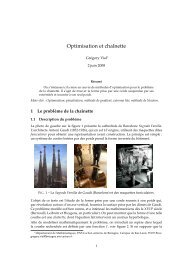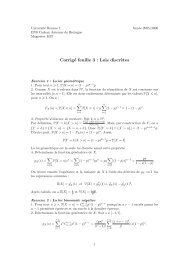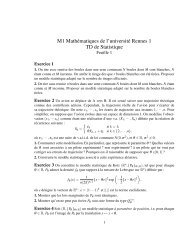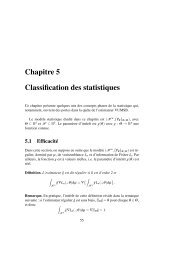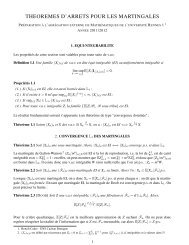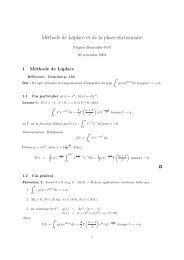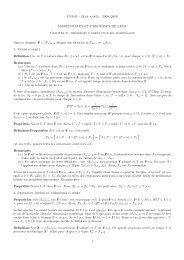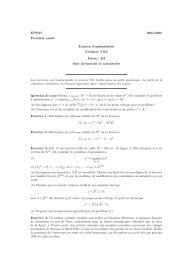best design for a fastest cells selecting process - ENS de Cachan ...
best design for a fastest cells selecting process - ENS de Cachan ...
best design for a fastest cells selecting process - ENS de Cachan ...
- No tags were found...
You also want an ePaper? Increase the reach of your titles
YUMPU automatically turns print PDFs into web optimized ePapers that Google loves.
2 MICHEL PIERRE AND GRÉGORY VIALwhere k is a strictly positive constant in the case of negative dielectrophoresis, and Θ = Θ(U ′ ) takesinto account the friction <strong>for</strong>ces (which are always present in the experiments un<strong>de</strong>r consi<strong>de</strong>ration).We want to control the shape of the electro<strong>de</strong>s so that the <strong>cells</strong> arrive as fast as possibleto the point where E 2 reaches its minimum. The network of electro<strong>de</strong>s is assumed to be periodic.Our strategy is as follows: we rst <strong>de</strong>termine what should be the <strong>best</strong> attracting eld Ein<strong>de</strong>pen<strong>de</strong>ntly of any constraint: this is essentially a control problem <strong>for</strong> a family of evolutionsystems which is mathematically interesting <strong>for</strong> itself. Then, we try to optimize the shape of theelectro<strong>de</strong>s in or<strong>de</strong>r to be as close as possible to this <strong>best</strong> eld. According to the law (1), the rststep consists in nding the <strong>best</strong> scalar function E 2 so that the solutions U(t) of (1), starting withzero velocity, reach the point where E 2 is minimum (say the origin) as fast as possible.A rst helpful reduction is the following (see Section 2.1 <strong>for</strong> a proof): let x 0 be a startingposition <strong>for</strong> a single particle with initial velocity zero. Given an attracting potential F = E 2 , onecan always replace it by a radial attracting eld of at most the same size, which will make theparticle reach the origin in a shorter time. It is well known that the shortest path to reach a pointin R 3 is a straight line; however, it is not always the <strong>fastest</strong> as it is well known in many situations.We prove in Section 2.1 that it is actually the case here. This is why we will mainly consi<strong>de</strong>r radialpotentials later on in this paper.A next question is the following: what is the <strong>best</strong> radial attracting potential to bring a particlethe <strong>fastest</strong> possible from its initial position x 0 to the origin? Actually, it is easy to see (cf.Section 2.1) that the answer will strongly <strong>de</strong>pend on the starting point x 0 . Since we are moreinterested in accelerating a group of particles with a same electric eld, we will rather minimizethe average time necessary <strong>for</strong> a distributed group of particles to reach the origin. This question isanalyzed in Section 3. We prove existence and uniqueness of a <strong>best</strong> scalar eld E 2 . Surprisingly,the question leads to integral equations, one of them being well-known in the literature as the Abelintegral equation see (24).Next, we will try to <strong><strong>de</strong>sign</strong> the <strong>fastest</strong> shapes of the electro<strong>de</strong>s by being as close as possibleto the previously obtained <strong>best</strong> radial attracting eld. We use a least square method and theobjective function to be minimized is an euclidian distance between the expected eld and the<strong>best</strong> eld found be<strong>for</strong>e. This is analyzed numerically in Section 4.2. Towards the optimization problem.2.1. Reduction to radial elds. As stated in the introduction, we prove here that one canalways do better (= faster) with radial elds. We will essentially discuss the case when Θ ≡ 0 (nofriction). As explained in Ÿ 2 and Theorem 2.2, it is not dicult to modify the analysis so as toinclu<strong>de</strong> this term. But the analysis is less technical without it and easier to read while nothing ofthe essential part is lost.We <strong>de</strong>note by | · | the euclidian norm in R N . Let F : R N \ {0} → [0, +∞) be a C 2 -function with∇F boun<strong>de</strong>d in a neighborhood of the origin 0 and F (0) := lim |r|→0 F (r) = 0. Let us consi<strong>de</strong>r thesolution ofU ′′ (t) = −∇F (U(t)), U(0) = x 0 , U ′ (0) = 0. (2)This solution exists globally in time since: |U ′ | 2 = 2[F (x 0 ) − F (U)] ≤ 2F (x 0 ). We assume thatU(T ) = 0 <strong>for</strong> some T > 0 and we set e 0 := x 0 /|x 0 |.Theorem 2.1. There exists t 0 ∈ [0, T ), τ ∈ (t 0 , T ], G ∈ C 1 [0, |x 0 |] andu ∈ C 2 ([t 0 , τ]; R N ) such that,∀t ∈ (t 0 , τ), u ′′ (t) = −G ′ (|u(t)|)e 0 , u(t 0 ) = x 0 , u ′ (t 0 ) = 0, (3)G(0) = 0, ‖G‖ ∞ = G(|x 0 |) ≤ F (x 0 ), ‖G ′ ‖ ∞ ≤ ‖∇F ‖ ∞ . (4)u(τ) = 0, and ∀ t ∈ [t 0 , τ], |u(t)| ≤ |U(t)|. (5)Remark 1. Let us set: ∀x ∈ R N , G(x) = G(|x|). Then, <strong>for</strong> x ∈ [0, x 0 ], one has ∇G(x) = G ′ (|x|)e 0 .This theorem shows that, given x 0 , we may replace the initial potential F by a radial potential Gin such a way that the accelerated particle u(t) reaches the origin at least as fast as (and most ofthe time, faster than) the previous one U(t) and this, with a potential G boun<strong>de</strong>d above by F aswell as ∇G boun<strong>de</strong>d above by ∇F see (4).




